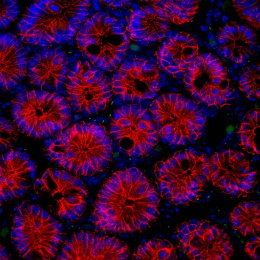Downstream Dreams 2: Investigating Melanoma in Zebrafish
Downstream Dreams 2: Investigating Melanoma in Zebrafish
Dahlia Perez, Adam Amsterdam, Jacqueline Lees
MIT Department of Biology, Koch Institute at MIT
Uveal melanoma (UM) is the most common adult primary eye tumor, and though successful treatments exist for the primary tumor, half of UM patients develop metastases within 15 years at which time their average survival is 6 months. Therefore, a desperate need exists for improved understanding and treatment of this disease. We have generated a model of UM in zebrafish driven by the same genetic changes that are responsible for inducing human UMs, specifically activating mutations in the GNAQ/GNA11 genes. In combination with other cancer-causing mutations, our fish develop melanomas with high frequency and die of this disease. In addition, transgenics display an array of pigmentation defects including hyperpigmentation and inappropriate localization of melanocytes, melanin producing cells and the cell of origin for melanomas. These pigmentation phenotypes result from potentially pro-tumorigenic changes in the melanocytes such as increases in proliferation, survival, and migration.
During development, the canonical zebrafish stripe pattern is formed as xanthophores form an interstripe along the midline of the fish. Through repulsive cues, wild type melanophores typically clear this interstripe region to form the darker stripes along the flanks of the fish. Interestingly, pictured here are the transgenic melanocytes ignoring the repulsive and apoptotic cues in the interstripe region.






